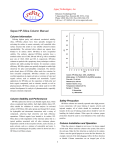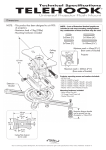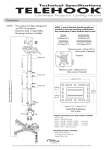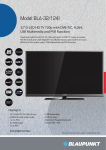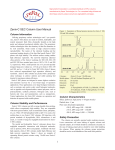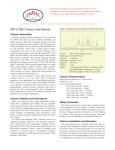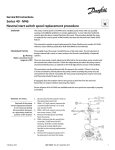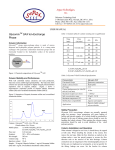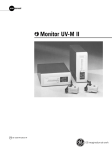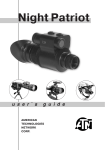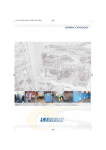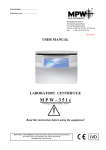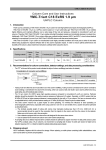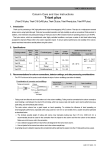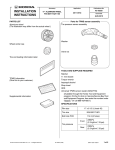Download User Manual
Transcript
Sepax Technologies, Inc. Delaware Technology Park 5 Innovation Way, Newark, DE 19711, USA Phone: (302) 366-1101; Fax: (302) 366-1151 Toll Free: 1-877-SEPAX-US; www.sepax-tech.com Sepax GP-Phenyl Column Manual protections should be used to avoid inhalation of the small silica particles. Column Information Utilizing highest purity and enhanced mechanical stability silica and pure bonding reagents, GP-Phenyl bonded phases have been innovatively and specially designed to ensure maximum mono-functional coverage and full end-capping, which leads to carbon content as high as 11.0%. The chemistry of monolayer formation and end-capping is completely controlled that results in very reliable column-to-column reproducibility. The maximum surface coverage allows GP-Phenyl to have exceptional stability. The uniform, spherical GP-Phenyl particles have a nominal surface area of 300 m2/g with a controlled pore size of 120Å. GPPhenyl columns are packed with a proprietary slurry technique to achieve uniform and stable packing bed density for maximum column efficiency. GP-Phenyl packing materials are bonded with phenyl groups that lead to fairly high hydrophobicity. GP-Phenyl columns have great selectivity and peak symmetry with fairly high retention for separations of acidic, neutral and basic organic compounds, such as drugs, peptides, organic acids. GP-Phenyl columns are especially designed for separation of various organic compounds with ring structure. Column: GP-Phenyl (5µm, 4.6x250mm) Mobile phase: 60% Methanol/40% H2O Detection: UV 254 nm Injection volume: 2 µL Temperature: Ambient Compounds: 1. Aniline 0.1% (V/V) 2. Anisole 0.2% (V/V) 3. Toluene 0.5% (V/V) 2 0.60 0.50 0.40 AU 3 0.30 1 0.20 Column Stability and Performance GP-Phenyl uses full coverage bonded silica packing, which allows exceptional high stability. Such high stability allows GPPhenyl extremely suitable for validation of various analytes. The unique mono-functional bonding chemistry for GP-Phenyl avoids the formation of multiple layers. Such uniform stationary phase allows the separation to achieve high selectivity and high efficiency. A typical test chromatogram for quality control is shown here for a 4.6x250mm GP-Phenyl column. Compared with GP-C18 phase, GP-Phenyl has relatively lower hydrophobicity. The high efficiency and less hydrophobicity of GP-Phenyl phase make it very suitable for separating compounds with a wide range of hydrophobicity. It is highly recommended for separating the compounds which are too strongly retained on C18 phases. 0.10 0.00 0.0 2.0 4.0 6.0 8.0 10.0 12.0 Min Column Installation and Operation When column is shipped or not in use, it is always capped at both ends. When install the column to the system, first remove the end caps. Make the flow direction as marked on the column. Unless a user has special purpose to reverse the flow direction, for example, removal of the inlet pluggage, follow the flow direction as labeled. Column connections are an integral part of the chromatographic process. If ferrules are over tightened, not set properly, or are not specific for the fitting, leakage can occur. Set the ferrules for column installation to the HPLC system as follows: Safety Precaution GP-Phenyl columns are normally operated under high pressure. Loose connections will cause leaking of organic solvents and injected samples, all of which should be considered as the hazards. In the case of leaking, proper gloves should be worn for handling the leaked columns. When open the columns, proper 1 Storage When not in use for extended time, do not allow water or aqueous buffer to remain in the column. Remove any aqueous buffers by washing with at least 20-30 column volumes of 50% methanol or acetonitrile aqueous solution, followed by 20-30 column volumes of the pure solvent such as acetonitrile. Each column is shipped with two removable end plugs. To prevent the drying of the column bed, seal both ends of the column with the end plugs provided. (a) Place the male nut and ferrule, in order, onto a 1/16" o.d. piece of tubing. Be certain that the wider end of the ferrule is against the nut. (b) Press tubing firmly into the column end fitting. Slide the nut and ferrule forward, engage the threads, and fingertighten the nut. (c) While continuing to press the tube firmly into the endfitting, use a 1/4" wrench to tighten the nut 90 degrees past fingertightness. (d) Repeat this coupling procedure for the other end of the column. New GP-Phenyl columns are shipped in a mixture of methanol or acetonitrile and water. During stocking and shipping, the silica packing could be dried out. It is recommended that 10-20 column volumes of pure organic solvents, such as methanol, acetonitrile be purged to activate the column. Flush the column with your mobile phase with gradual increasing the flow rate from 0.1 mL/min to your operation condition, until the baseline is stable. If the column backpressure and baseline fluctuate, this might be due to the air bubbles trapped inside the column. Flush the column with higher flow rate for 2-5 minutes, for example 2 mL/min for 4.6x150mm. GP-Phenyl Products ID x Length Samples and Mobile Phases To avoid clogging the column, all samples and solvents including buffers should be filtered through 0.45 µm or 0.2 µm filters before use. GP-Phenyl bonded stationary phase is nonpolar in nature. It is recommended that the mobile phase be a mixture of organic solvent, such as methanol or acetonitrile and water, even though GP-Phenyl can tolerate aqueous buffers as mobile phases. Always degas the mobile phase. A simple way for degassing is to sonicate it for 5 minutes under water pumped vacuum. Gradient elution methods for GP-Phenyl columns often begin with 5% methanol or acetonitrile as the initial mobile phase. Column Care PH Avoid use of the column below pH 2 or above 9. Higher pH will dissolve silica, creating defects of bonding that causes separation efficiency loss and retention time change. The optimum performance and operation for longest lifetime are at pH 2 - 8.5. Pressure Even though GP-Phenyl can operate at pressure up to 5,000 psi, the normal operation is usually under 3,000 psi. Continuous use at high pressure may eventually damage the column as well as the pump. Since the pressure is generated by the flow rate. The maximum flow rate is limited by the backpressure. It is expected that the backpressure might gradually increase with its service. A sudden increase in backpressure suggests that the column inlet frit might be plugged. In this case it is recommended that the column be flushed with reverse flow in an appropriate solvent. Temperature The maximum operating temperature is 60oC. Continuous use of the column at higher temperature (>75oC) can damage the column, especially under high pH (>8.5). 2 2.1x150mm 2.1x100mm 2.1x50mm 2.1x30mm Particle size 3 µm 3 µm 3 µm 3 µm Pore size 4.6x250mm 4.6x150mm 4.6x100mm 4.6x50mm 3 µm 3 µm 3 µm 3 µm 120 Å 120 Å 120 Å 120 Å 111363-4625 111363-4615 111363-4610 111363-4605 2.1x250mm 2.1x150mm 2.1x100mm 2.1x50mm 2.1x30mm 5 µm 5 µm 5 µm 5 µm 5 µm 120 Å 120 Å 120 Å 120 Å 120 Å 111365-2125 111365-2115 111365-2110 111365-2105 111365-2103 4.6x250mm 4.6x150mm 4.6x100mm 4.6x50mm 5 µm 5 µm 5 µm 5 µm 120 Å 120 Å 120 Å 120 Å 111365-4625 111365-4615 111365-4610 111365-4605 7.8x250mm 10.0x250mm 21.2x250mm 21.2x150mm 21.2x50mm 5 µm 5 µm 5 µm 5 µm 5 µm 120 Å 120 Å 120 Å 120 Å 120 Å 111365-7825 111365-10025 111365-21225 111365-21215 111365-21205 7.8x250mm 10.0x250mm 21.2x250mm 21.2x150mm 21.2x50mm 10 µm 10 µm 10 µm 10 µm 10 µm 120 Å 120 Å 120 Å 120 Å 120 Å 120 Å 120 Å 120 Å 120 Å P/N 111363-2115 111363-2110 111363-2105 111363-2103 111369-7825 111369-10025 111369-21225 111369-21215 111369-21205


